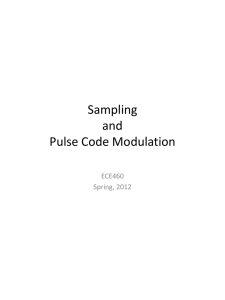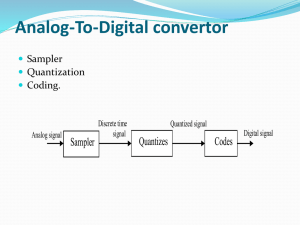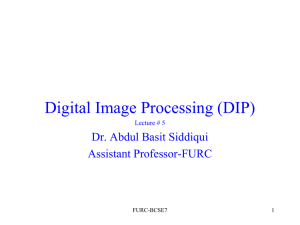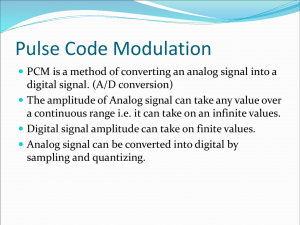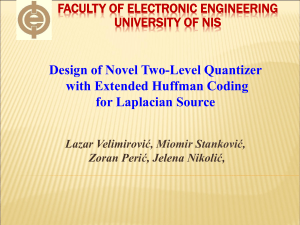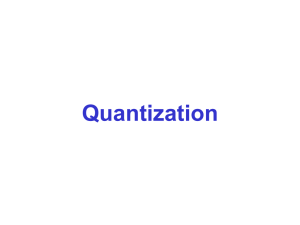Context Quantization - McMaster University
advertisement
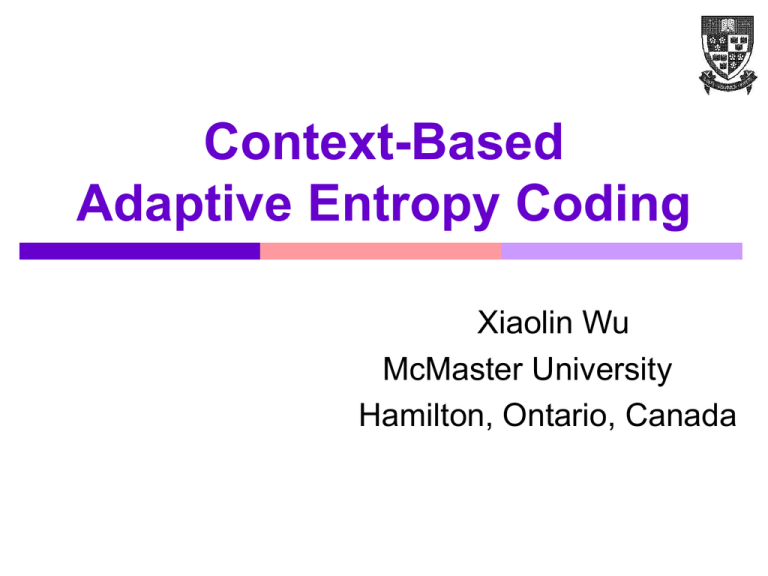
Context-Based
Adaptive Entropy Coding
Xiaolin Wu
McMaster University
Hamilton, Ontario, Canada
Data Compression System
Transform
a block of n
samples
Entropy
Coding
Quantization
transform
coefficients
bit patterns for
the Q-indices
quantized
coefficients
lossless compression (entropy coding) of the
quantized data
entropy coding removes redundancy and achieves
compression
2
Entropy Coding Techniques
Huffman code
Golomb-Rice code
Arithmetic code
Optimal in the sense that it can approach source entropy
Easily adapts to non-stationary source statistics via context
modeling (context selection and conditional probability
estimation).
Context modeling governs the performance of arithmetic coding.
3
Entropy (Shannon 1948)
Consider a random variable
source alphabet : {x0 , x1,...,xN 1}
probability mass function : pX ( xi ) prob( X xi )
Self-information of xi is i( xi ) log P( xi )
X
measured in bits if the log is base 2.
event of lower the probability carries more information
Self-entropy is the weighted average of self
information
H ( X ) P( xi ) log P( xi )
i
4
Conditional Entropy
Consider two random variables
X
and C
Alphabet of X : {x0 , x1,...,xN 1}
Alphabet of C : {c0 , c1 ,...,cM 1}
Conditional Self-information of xi is
i( xi | cm ) log P( xi | cm )
Conditional Entropy is the average value of
conditional self-information
N 1 M 1
H ( X | C ) P( xi | cm ) P(cm ) log2 P( xi | cm )
i 0 m 0
5
Entropy and Conditional Entropy
The conditional entropy H ( X | C ) can be interpreted
as the amount of uncertainty remaining about the X ,
given that we know random variable C .
The additional knowledge of C should reduce the
uncertainty about X .
H ( X | C) H ( X )
6
Context Based Entropy Coders
Consider a sequence of symbols
S
symbol to code
form the context space, C
0 0 1 0 0 1 1 0 1 1 1 0 1 0 0 1 0 0 0 0 1 0 0 1 1 1 0 1 0 1 1 0 1 1 0 1 1 0 ...
C0 0 0 0
C1 0 0 1
C7 1 1 1
EC
EC
H (C0 )
H (C1 )
R
P(C )H (C )
i
i
i
EC
H (C7 )
7
Context model – estimated
conditional probability
Variable length coding schemes need estimates of
probability of each symbol - model
Model can be
Static - Fixed global model for all inputs
Semi-adaptive - Computed for specific data being coded
and transmitted as side information
English text
C programs
Adaptive - Constructed on the fly
Any source!
8
Adaptive vs. Semi-adaptive
Advantages of semi-adaptive
Disadvantages of semi-adaptive
Overhead of specifying model can be high
Two-passes of data required
Advantages of adaptive
Simple decoder
one-pass universal As good if not better
Disadvantages of adaptive
Decoder as complex as encoder
Errors propagate
9
Adaptation with Arithmetic
and Huffman Coding
Huffman Coding - Manipulate Huffman tree on the
fly - Efficient algorithms known but nevertheless
they remain complex.
Arithmetic Coding - Update cumulative probability
distribution table. Efficient data structure / algorithm
known. Rest essentially same.
Main advantage of arithmetic over Huffman is the
ease by which the former can be used in conjunction
with adaptive modeling techniques.
10
Context models
If source is not iid then there is complex dependence between
symbols in the sequence
In most practical situations, pdf of symbol depends on
neighboring symbol values - i.e. context.
Hence we condition encoding of current symbol to its context.
How to select contexts? - Rigorous answer beyond our scope.
Practical schemes use a fixed neighborhood.
11
Context dilution problem
The minimum code length of sequence x1 x2 xn
achievable by arithmetic coding, if P( xi | xi 1xi 2 x1 )
is known.
The difficulty in estimating P( xi | xi 1 xi 2 x1 ) due to
insufficient sample statistics, preventing the use of
high-order Markov models.
12
Estimating probabilities in
different contexts
Two approaches
Maintain symbol occurrence counts within each context
number of contexts needs to be modest to avoid context dilution
Assume pdf shape within each context same (e.g.
Laplacian), only parameters (e.g. mean and variance)
different
Estimation may not be as accurate but much larger number of
contexts can be used
13
Context Explosion
Consider an image
quantized to 16-levels
“causal” context space
65,536 contexts!
No enough data to “learn” the histograms
the data dilution problem
solution: “quantize” the context space
14
Current Solutions
Non-Binary Source
JPEG: simple entropy coding without context
J2K: ad-hoc context quantization strategy
Binary Source
JBIG: use suboptimal context templates of modest sizes
15
Overview
Introduction
Context Quantization for Entropy Coding of Non-Binary
Source
Context Quantization for Entropy Coding of Binary Source
Context Quantization
Context Quantizer Description
Minimum Description Length Context Quantizer Design
Image Dependent Context Quantizer Design with Efficient Side Info.
Context Quantization for Minimum Adaptive Code Length
Context-Based Classification and Quantization
Conclusions and Future Work
16
Context Quantization
S
Define
Context
C1 C256
Quantize
Context
Gm
Estimate
Prob.
p(S | Gm ) Entropy
Bits
Coders
G1
Adaptive arithmetic coder 1
GN
Adaptive arithmetic coder N
C25 C1000
C3021 C4021
Ci
Group the contexts with similar histogram
17
Distortion Measure
Kullback-Leibler distance between pmf histograms
Always non-zero
d (T , R) H (T || R )
T
k
log(Tk / Rk )
k
0.5
0.4
prob.
prob.
0.3
0.2
0.1
0
1
2
3
4
symbol value (k)
T (0.3,0.2,0.1,0.4)
d (T , R) 0.28bits / sym
0.6
0.5
0.4
0.3
0.2
0.1
0
1
2
3
4
symbol value (k)
R (0.5,0.1,0.2,0.2)
d (T , T ) d ( R, R) 0bits / sym
18
Context Quantization
GLA (k-mean)
algorithm
Nearest Neighbor
Centroid Computation
Context
Histograms
Centroid
Histogtrams
Voronoi
Region
Repeat until converge
19
Experimental Results
1st experiment: source
use a controlled source with memory
1st-order Gauss-Markov
x[n]= r x[n - 1]+ w[n]
generate 107 samples with r = 0.9
quantize into 32 levels
flip sign of every sample with probability 0.5
20
1st experiment setup
context space
L3
L2
context size = 1024
L1
S
all the dependence is here
How many groups do we expect?
max of 16 are needed
all will be bimodal
21
1st experiment: results
vary M, the number of groups
M
Rate [bits/sym]
1
4.062
2
3.709
4
3.563
8
3.510
16
3.504
774
3.493
only need 8!
number of non-empty contexts
22
histograms for M=16
0.25
probability
0.2
0.15
0.1
0.05
0
1
3
5
7
9 11 13 15 17 19 21 23 25 27 29 31
symbol value (16 corresponds to zero)
23
2nd experiment: source
a 512512 “natural image” - barb
wavelet transform, 9-7 filters, 3-levels
each subband scalar quantized to 24 levels
S0
test a sub-image
24
2nd experiment: setup
context space
L4
L3
L1
S
L2
context size = 313,776
group histogram structure?
unknown
25
2nd experiment: results
subband S0 (low pass)
estimated entropy
true rate
5
4
Rate [bits/pixel]
3
2
1
0
1
2
4
8
16
32
64
128
256 3020
Number of Groups
need our method to quantize the context space!
26
Overview
Introduction
Context Quantization for Entropy Coding of Non-Binary
Source
Context Quantization for Entropy Coding of Binary Source
Context Quantization
Context Quantizer Description
Minimum Description Length Context Quantizer Design
Image Dependent Context Quantizer Design with Efficient Side Info.
Context Quantization for Minimum Adaptive Code Length
Context-Based Classification and Quantization
Conclusions and Future Work
27
Quantizer description
G1
GN
S
C1
Define
Context
C25
C1000
C1021
Ci Quantize
Context
C1197
G
m
Estimate
Prob.
Describe
Context
Book
p(S | Gm )
SideBits
Entropy DataBits
Coders
G1
Adaptive arithmetic coder 1
GN
Adaptive arithmetic coder N
C26 C25 C1000
C1021C1197
28
Coarse Context Quantization
output
Full Resolution Quantizer
Low Resolution
Context Quantizers
Number of contexts
0
input
X2
X1
X0
0
0
0
9*9*9=729
6*5*3=90
S
0
29
State Sequence
…8 6 5
2 4 3 5 8 6 5 4 1 2 4 3 1 8 6 5 2 2 7…
… G3 … … … … … G3 … … … …
G1
C25
C1000
Context Book
GN
C1021
C1197
Context Indices
C1021
C25
C1000
C1197
Group Indices
GN
G1
G1
GN
30
Experimental Results
Experiment: source
a 512512 “natural image” - barb
wavelet transform, 9-7 filters, 3-levels
each subband scalar quantized to 24 levels
31
Experimental Results
2
Side Rate
(bpp)
1.5
Direct
CM
1
0.5
0
???
HL1 LH1 HH1 HL2 LH2 HH2 HL3 LH3 HH3
32
Experimental Results
Side Information Rate
2.4
Data Rate
1.8
2.1
1.5
1.8
1.2
1.5
Bit Rate
1.2
(bpp)
0.9
Bit Rate
0.9
(bpp)
0.6
0.6
0.3
0.3
0
No Context
Grouping
Direct
CM
CCQ +CM
Subband LH2
0
No
Context
Grouping
Direct
CM
CCQ +CM
Subband LH3
33
Overview
Introduction
Context Quantization for Entropy Coding of Non-Binary
Source
Context-Based Classification and Quantization
Context Quantization for Entropy Coding of Binary Source
Context Quantization
Context Quantizer Description
Minimum Description Length Context Quantizer Design
Image Dependent Context Quantizer Design with Efficient Side Info.
Context Quantization for Minimum Adaptive Code Length
Conclusions and Future work
34
MDL-Based Context Quantizer
G1
GN
S
C1
Define
Context
C25
C1000
C1021
Ci Quantize
Context
C1197
G
m
Estimate
Prob.
Describe
Context
Book
p(S | Gm )
SideBits
Entropy DataBits
Coders
G1
Adaptive arithmetic coder 1
GN
Adaptive arithmetic coder N
C26 C25 C1000
C1021C1197
35
Distortion Measure
0.9
0.7
0.8
1
0.9
0.6
0.8
0.7
0.4
0.3
0.5
0.7
0.4
0.6
0.5
Prob.
0.5
Prob.
Prob.
0.6
0.3
0.2
0.2
0.1
0.1
0
0.1
0
0
0
1
0
Symbol Value
1
0
Symbol Value
A(0.2,0.8)
0.1
0.2
C(0.9,0.1)
B
0.3
0.4
C
0.5
0.6
1
Symbol Value
B(0.4,0.6)
A
0
0.4
0.3
0.2
0.7
0.8
0.9
1.0
Z P(0)
d ( A, B) d ( A, C )
36
Context Quantization
Vector Quantization
(Local Optima)
Context
Histograms
Centroid
Histogtrams
q1
Scalar Quantization
(Global Optima)
0
0.1
Voronoi
Region
q2
0.2
0.3
0.4
qM
0.5
0.6
0.7
0.8
0.9
1.0
min (code length)
q1 , q2 ,..., qM
37
Proposed Method
Context mapping description
Using training set to obtain pmf of “common” context
Applying classification map method for “rare” context
Minimum Description Length Context Quantizer
Minimize the objective function
M
M
n{Z (qm 1, qm ]}
min N{Z (qm1 , qm ]}H ( X | Z (qm1 , qm ]) n{Z (qm 1, qm ]}log
q,M
n
{
Z
[
0
,
1
]}
m 1
m1
Data Code Length
Side Info. Code Length
Dynamic programming method is applied to achieve the
global minima
38
Contributions
A new context quantizer design approach based on
the principle of minimum description length.
An input-dependent context quantizer design
algorithm with efficient handling of rare contexts
Context quantization for minimum adaptive code
length.
A novel technique to handle the mismatch of
training statistics and source statistics.
39
Experimental Results
Bit rates (bpp) of dithering halftone images
Bit rates (bpp) of error diffusion halftone images
40
Overview
Introduction
Context Quantization for Entropy Coding of Non-Binary
Source
Context Quantization for Entropy Coding of Binary Source
Context Quantization
Context Quantizer Description
Minimum Description Length Context Quantizer Design
Image Dependent Context Quantizer Design with Efficient Side Info.
Context Quantization for Minimum Adaptive Code Length
Context-Based Classification and Quantization
Conclusions and Future Work
41
Motivation
MDL-based context quantizer is designed mainly
based on the training set statistics.
If there is any mismatch in statistics between the
input and the training set, the optimality of the
predesigned context quantizer can be compromised
42
Input-dependent context
quantization
Context Quantizer Design
Raster scan the input image to obtain the conditional
probabilities Px|c (1 | c) and the number of occurrence N (c)
of each context instance c
Minimize the objective function by dynamic programming
M
min N{Z (qm1 , qm ]}H ( X | Z (qm1 , qm ])
q,M
m 1
Reproduction pmfs m Px|Q(c ) (1 | m), m 0,...,M 1 are sent as
the side information
43
Handling of Rare Context
Instances
Context template definition
Estimation of conditional probabilities from the
training set
Rare contexts : estimated by decreased size context
Only used as initial one and being updated when coding the
input image
44
Coding Process
S Context
Calculation
c Prob.
Estimation
Pˆx | c (1 | c) Context
Quantization
Q(c) m
m
Entropy DataBits
Coders
Update
Pˆx|c (1 | c)
The context quantizer output may change according to
the more accurate estimate of the conditional
probability along the way
45
Experimental Results
Bit rates (bpp) of error diffusion halftone images
46
Overview
Introduction
Context Quantization for Entropy Coding of Non-Binary
Source
Context Quantization for Entropy Coding of Binary Source
Context Quantization
Context Quantizer Description
Minimum Description Length Context Quantizer Design
Image Dependent Context Quantizer Design with Efficient Side Info.
Context Quantization for Minimum Adaptive Code Length
Context-Based Classification and Quantization
Conclusions and Future Work
47
Motivation
To minimize the actual adaptive code length
instead of static code length
To minimize the effect of mismatch between the
input and training set statistics
48
Context Quantization for
Minimum Adaptive Code Length
The adaptive code length can be calculated
0
n0 1
n1 1
(
j
)
( j )
j 0
j 0
l log
n0 n1 1
j 0 (2 j )
n0 n1 1
( j )
j 0
log n0 n1 1
j 0 (2 j )
n0 0 and n1 0,
n0 0 and n1 0,
n0 0 xor n1 0,
The order of 0 and 1 appearance does not change
the adaptive code length
49
Context Quantization for
Minimum Adaptive Code Length
The objective function to minimize the effect of
mismatch between the input and the training set
min lm (n
M
M ,Q ( c ) m1
0
'n0 , n1 'n1 ) l (n0 ' , n1 ' )
m
50
Experimental Results
Bit rates (bpp) of error diffusion halftone images
51
Overview
Introduction
Context Quantization for Entropy Coding of Non-Binary
Source
Context Quantization for Entropy Coding of Binary Source
Context Quantization
Context Quantizer Description
Minimum Description Length Context Quantizer Design
Image Dependent Context Quantizer Design with Efficient Side Info.
Context Quantization for Minimum Adaptive Code Length
Context-Based Classification and Quantization
Conclusions and Future Work
52
Motivation
pdf
Single Quantizer
pdf
Quantizer after Classification
53
Single Quantizer
T
Q
EC
prob
Transform Coef.
54
Classification and Quantization
TC
T
IQ
C
Q
EC
…20.5 40.5 31
9 45
38 28 12 25 39.5 47 19
Initial Q
…2
4
3
0
4
3
2
1
2
3
4
1
2 …
Group Indies
…0
1
1
0
1
1
0
0
0
1
1
0
1 …
Transform Coef.
23.5…
C0
C1
G0
GN
CM
55
Experimental Results
56
Overview
Introduction
Context Quantization for Entropy Coding of Non-Binary
Source
Context Quantization for Entropy Coding of Binary Source
Context Quantization
Context Quantizer Description
Minimum Description Length Context Quantizer Design
Image Dependent Context Quantizer Design with Efficient Side Info.
Context Quantization for Minimum Adaptive Code Length
Context-Based Classification and Quantization
Conclusions and Future Work
57
Conclusions
Non-Binary Source:
Binary Source:
New context quantization method is proposed
Efficient context description strategies
Global optimal partition of the context space
MDL-based context quantizer
Context-based classification and quantization
58
Future Work
Context-based entropy coder
Classification and Quantization
Context shape optimization
Mismatch between the training set and test data
Classification tree among the wavelet subbands
Apply these techniques to video codec
59
?
60
